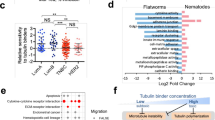Abstract
We examined the effects of macrolide antibiotics on tumor angiogenesis, tumor growth and metastasis in the B16BL6 mouse melanoma and C57BL mouse system. Two 14-membered ring macrolide antibiotics, roxithromycin and clarithromycin, significantly reduced the dense capillary network area in a mouse dorsal air sac angiogenesis model, whereas a 15-membered ring macrolide, azithromycin, and a 16-membered ring macrolide, josamycin, did not show any inhibitory effect on angiogenesis at the same dose. Intraperitoneal administration of roxithromycin and clarithromycin at 50 mg/kg/day reduced the tumor size of B16BL6 melanoma to about 41% and 56%, respectively, of that of the control, and significantly suppressed pulmonary metastasis of B16BL6 cells in a spontaneous system. Azithromycin and josamycin, on the other hand, did not inhibit tumor growth or pulmonary metastasis of B16BL6 cells. Immunohistochemistry revealed that roxithromycin and clarithromycin reduced the tumor vascularity and increased apoptosis of the tumor cells in vivo. These results suggest that 14-membered ring macrolides have antiangiogenic and antitumor effects and might have possible therapeutic applications.
Similar content being viewed by others
References
Folkman J. Tumor angiogenesis. In Mendelsohn J, Howley PM, Israel MA, Liotta LA (eds): The Molecular Basis of Cancer. Philadelphia: W.B. Saunders 1995; 206–32.
Folkman J. Angiogenesis in cancer, vascular, rheumatoid and other disease. Nat Med 1955; 1: 27–31.
Folkman J. Clinical applications of research on angiogenesis. N Engl J Med 1995; 333: 1757–63.
O'Reilly MS, Holmgren L, Shing Y et al. Angiostatin: a novel angiogenesis inhibitor that mediates the suppression of metastases by a Lewis lung carcinoma. Cell 1994; 79: 315–28.
O'Reilly MS, Boehm T, Shing Y et al. Endostatin: an endogenous inhibitor of angiogenesis and tumor growth. Cell 1997; 88: 277–85.
Karp JE, Broder S. Molecular foundations of cancer: new targets for intervention. Nat Med 1995; 1: 309–20.
Agen C, Danesi R, Blandizzi C et al. Macrolide antibiotics as antiinflammatory agents: roxithromycin in an unexpected role. Agents Actions 1993; 38: 85–90.
Kadota J, Saito O, Kohno S, Hara K. A mechanism of erythromycin treatment in patients with diffuse panbronchiolitis. Am Rev Respir Dis 1993; 147: 153–9.
Oishi K, Sonoda F, Kobayashi S et al. Role of interleukin-8 (IL-8) and an inhibitory effect of erythromycin on IL-8 release in the airways of patients with chronic airway diseases. Infect Immun 1994; 62: 4145–52.
Takizawa H, Desaki M, Ohtoshi T et al. Erythromycin suppresses interleukin-6 expression by human epithelial cells: a potential mechanism of its anti-inflammatory action. Biochem Biophys Res Commun 1995; 210: 781–6.
Mitsuyama T, Hidaka K, Furuno T, Hara N. Neutrophil-induced endothelial cell damage: inhibition by a 14-membered ring macrolide through the action of nitric oxide. Int Arch Allergy Immunol, 114: 111- 5.
Yatsunami J, Tsuruta N, Wakamatsu K et al. Clarithromycin is a potent inhibitor of tumor induced angiogenesis. Res Exp Med (Berlin) 1997; 197: 189–97.
Yatsunami J, Tsuruta N, Hara N, Hayashi S. Inhibition of tumorinduced angiogenesis by roxithromycin, a 14-membered ring macrolide antibiotic, Cancer Lett 1998; 131: 137–44.
Yatsunami J, Tsuruta N, Fukuno Y et al. Inhibitory effects of roxithromycin on tumor angiogene sis, growth and metastasis of mouse B16 melanoma cells, Clin Exp Meatstasis 1999; 17: 119–25.
Taniguchi S, Fujiki H, Kobayashi H et al. Effect of (–)-epigallocatechin gallate, the main constituent of green tea, on lung metastasis with mouse B16 melanoma cell lines. Cancer Lett 1992; 65: 51–4.
Yatsunami J, Tsuruta N, Ogata K et al. Interleukin-8 participates in angiogenesis in non-small cell, but not small cell carcinoma of the lung. Cancer Lett 1997; 120: 101–8.
Arenberg DA, Keane MP, DiGiovine B et al. Epithelial-neutrophil activating peptode (ENA-78) is an important angiogenic factor in non-small cell lung cancer. J Clin Invest 1998; 102: 465–72.
Neu HC. Antibacterial therapy: problems and promises, part II. Hosp Pract 1990; 25 (6): 181–94.
Peters DH, Friedel HA, McTavish D. Azithromycin: a review of antimicrobial activity, pharmacokinetic properties and clinical efficacy. Drugs 1992; 44: 750–99.
Konno S, Adachi M, Asano K et al. Influence of roxithromycin on cell-mediated immune responses. Life Sci 1992; 51: 107–12.
Yoshimura T, Kurita C, Yamazaki F et al. Effects of roxithromycin on proliferation of peripheral blood mononuclear cells and production of lipopolysaccharide-induced cytokines. Biol Pharm Bull 1995; 18: 876–81.
Hamada K, Kita E, Sawaki M, Mikasa K, Narita N. Antitumor effect of erythromycin in mice. Chemotherapy 1995; 41: 59–69.
Sassa K, Mizushima Y, Fujishita T et al. Therapeutic effect of clarithromycin on a transplanted tumor in rats. Antimicrob Agents Chemother 1999; 43: 67–72.
Mikasa K, Sawaki M, Kita E et al. Significant survival benefit to patients with advanced non-small cell lung cancer from treatment with clarithromycin. Chemotherapy 1997; 43: 288–96.
Pierce M, Clampton S, Henry D et al. A randomized trial of clarithromycin as prophylaxis against disseminated Mycobacterium avium complex infection in patients with advanced Acquired Immunodefficiency Syndrome. N Engl J Med 1996; 335: 384–91.
Jablonowski H, Fatkenheuer G, Youle M et al. Ancillary benefits of Mycobacterium avium-intracellulare complex prophylaxis with clarithromycin in HIV-infected patients. Drugs 1997; 54 (Suppl 2): 16–22.
Twardowski P, Gradishar WJ. Clinical trials of antiangiogenic agents. Curr Opin Oncol 1997; 9: 584–9.
Tamargo RJ, Bok RA, Brem H. Angiogenesis inhibition by minocycline. Cancer Res 1991; 51: 672–5.
Ono M, Kawahara N, Goto D et al. Inhibition of tumor growth and neovascularization by an anti-gastric ulcer agent, irsogladine. Cancer Res 1996; 56: 1512–6.
Volpert OV, Ward WF, Lingen MW et al. Captopril inhibits angiogenesis and slows the growth of experimental tumors in rats. J Clin Invest 1996; 98: 671–9.
Shirai T, Sato A, Chida K. Effect of 14-membered ring macrolide therapy on chronic respiratory tract infections and polymorphonuclear leukocyte activity. Intern Med 1995; 34: 469–74.
Author information
Authors and Affiliations
Rights and permissions
About this article
Cite this article
Yatsunami, J., Fukuno, Y., Nagata, M. et al. Antiangiogenic and antitumor effects of 14-membered ring macrolides on mouse B16 melanoma cells. Clin Exp Metastasis 17, 359–365 (1999). https://doi.org/10.1023/A:1006605725619
Issue Date:
DOI: https://doi.org/10.1023/A:1006605725619




